Jemaa el-Fnaa Market and Food Tour
Jemaa el-Fnaa is a square and marketplace in Marrakech’s Medina Quarter (old city). This square has served as one of the main cultural spaces since it was first founded in the late eleventh century and is a symbol of Marrakech. Jemaa el-Fnaa is filled with people daily, functioning as both a day and night market, including food stands, snake charmers, monkey wranglers, juice stands, and many other exciting cultural experiences.
When to Visit?
Jemaa el-Fnaa is open daily from 8 a.m. to 12 a.m. However, as long as people are still in the square, the market remains open. I would recommend visiting the Jemaa el-Fnaa both during the daytime and nighttime to see how the experience varies and to see all of the different vendors.
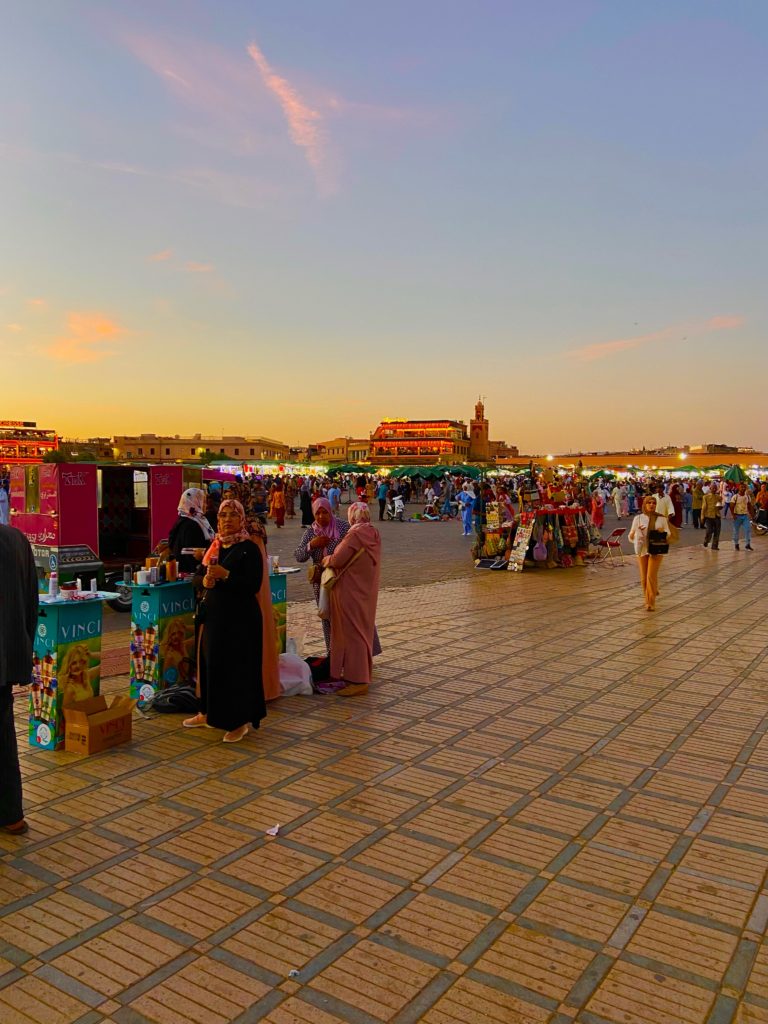

During the daytime, you will find that the square is not as busy, and the vendors are not as aggressive. You will see endless juice stands, merchants selling different goods and snake charmers. If you are visiting the market to bargain for goods and see the unique items available for sale, I would definitely recommend doing this during the daytime.
Once nighttime comes, the market becomes much more lively. The merchants move to the edges of the square, and the center becomes filled with different restaurants and food vendors. Overall, the daytime and nighttime market experiences are very different, and I highly recommend seeing it during both times.
Market Recommendations
After visiting the market many times and at all different hours of the day, there are many things that are a must-do/try. However, a few activities are tourist traps and end up being a total waste of money. The market is extremely affordable, allowing tourists to experience many local traditions and delicacies.
Day Time Market Tour
Arrive at Jemaa el-Fnaa around 10 a.m. local time. The market first opens at 8 a.m., but there is no need to get there early. The locals can take their time setting up and unless you are looking to only get juice, then there will not be too many stands open yet. Arriving at the market around 10 a.m. will guarantee that the market is fully up and running prior to your arrival.
When you first arrive you can stop and get a mint tea or Moroccan coffee. You will see different vendors pushing around their coffee/tea carts, and you can quickly stop to get a morning drink prior to wandering around the market. A cup of tea or coffee will cost around 5 Moroccan Dirhams or 50 cents USD.
Once you get your morning refreshment, you should walk around the market to see all the different vendors. You can explore the shops and varying products available for sale. You will see vendors selling sporting jerseys, teapots, hats, shoes, and pretty much anything you can think of.
You can finish your morning market experience by stopping at a juice stand. There’s no shortage of juice stands in Jemaa el-Fnaa, and you will find that each one is as good as the next. The vendors sell a variety of juices ranging from Orange Juice to Avocado Juice. One cup of juice will cost between 4-10 dirhams or about 40 cents to $1 USD.
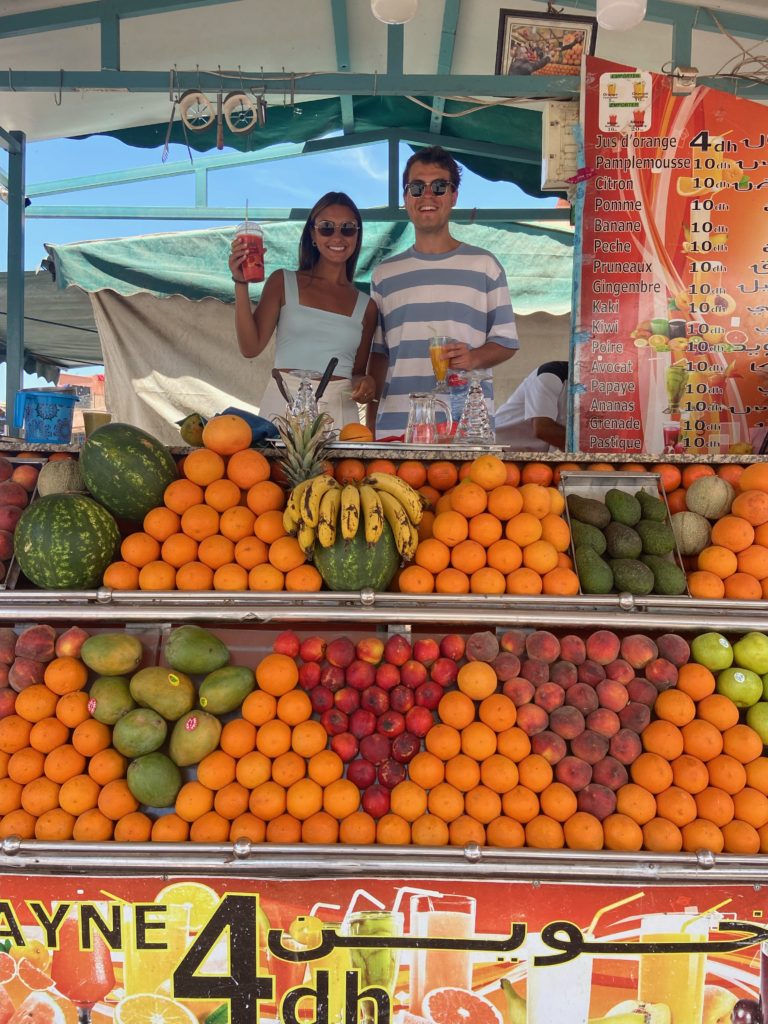

Night Time Market Tour
Visiting Jemaa el-Fnaa during the nighttime is a once-in-a-lifetime experience. The market completely transformed from what it was during the daytime. All the merchants selling clothing and other items are replaced with food vendors and restaurant owners displaying the local delicacies.
While the shop options change from what it was during the daytime, so does the merchant’s behavior towards their customers. While you can bargain and people are very inviting during the day. During the nighttime, if the restaurant owners spot that you are a tourist, they will swarm and hassle you until you agree to check out their menu or eat at their establishment.
With that said, the restaurants are terrific, affordable, and offer a first-hand look at what the locals eat. Our Jemaa el-Fnaa food tour consisted of stopping at three food stalls/ restaurants, one juice stand, and one dessert cart.
Food Tour
Stop 1 – Stall #5 Snail Soup
Our first stop on our Jemaa el-Fnaa food tour was for some snail soup, or as the locals call it, Babbouche or ghlal.
This delicacy is eaten by locals mostly during winter, as they believe the warm broth has health benefits. We were glad that we stopped and tried the snail soup. However, the broth was very salty, and after eating a few snails, I was more than ready to be done.
Overall, it was a great experience! We rate it a solid 6.7/10.
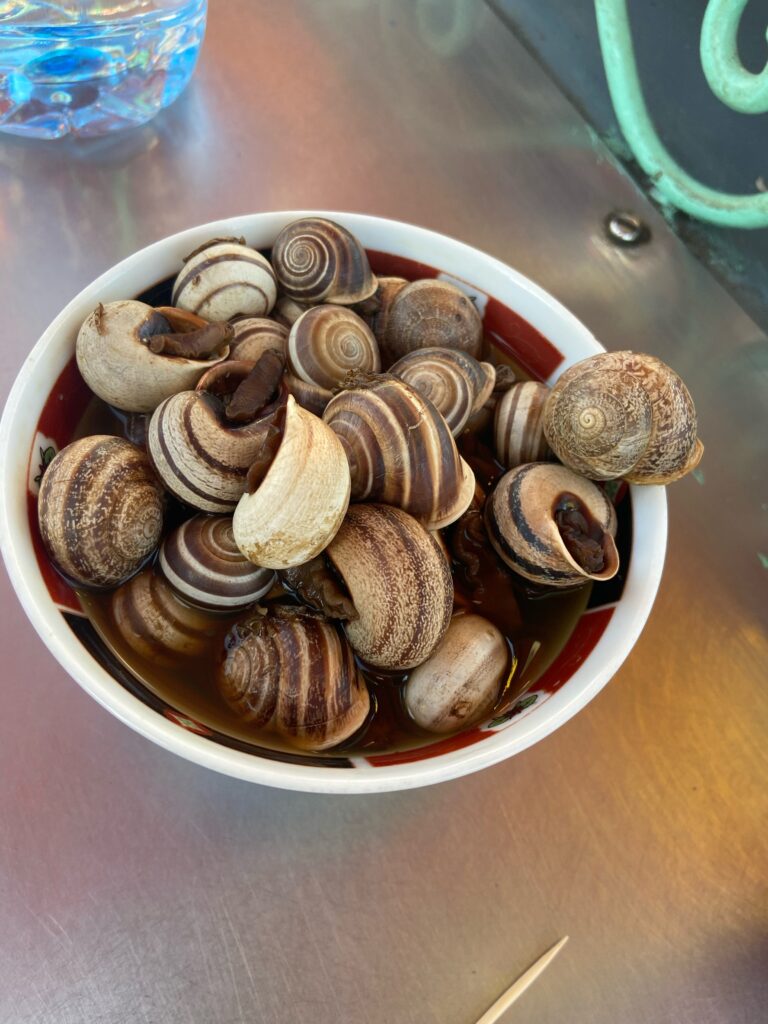
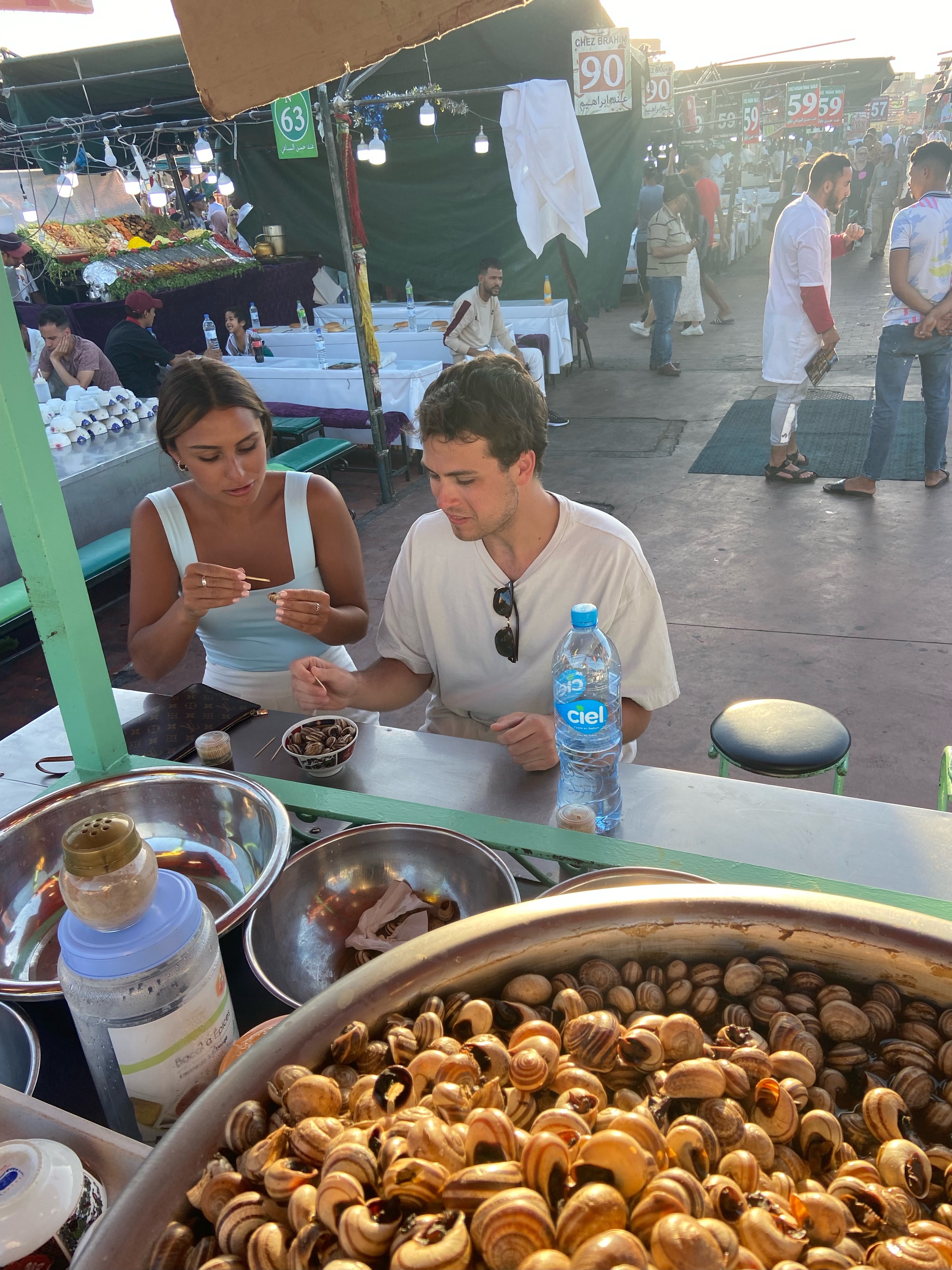
Stop 2 – Stall #13 Tangia
Our second stop on the food tour was for some mint tea and Tangia.
Tangia is a Moroccan dish traditionally prepared in a clay pot called a Tania. Within the Tania, they slowly cook a lamb shank with different spices and herbs over ashes from a wood fire. It is then poured over a plate and served with bread. We were served mint tea, along with our Tangia.
We loved all of our food and the restaurant owner did not even hassle us to come in. We would rate it an 8.9/10.
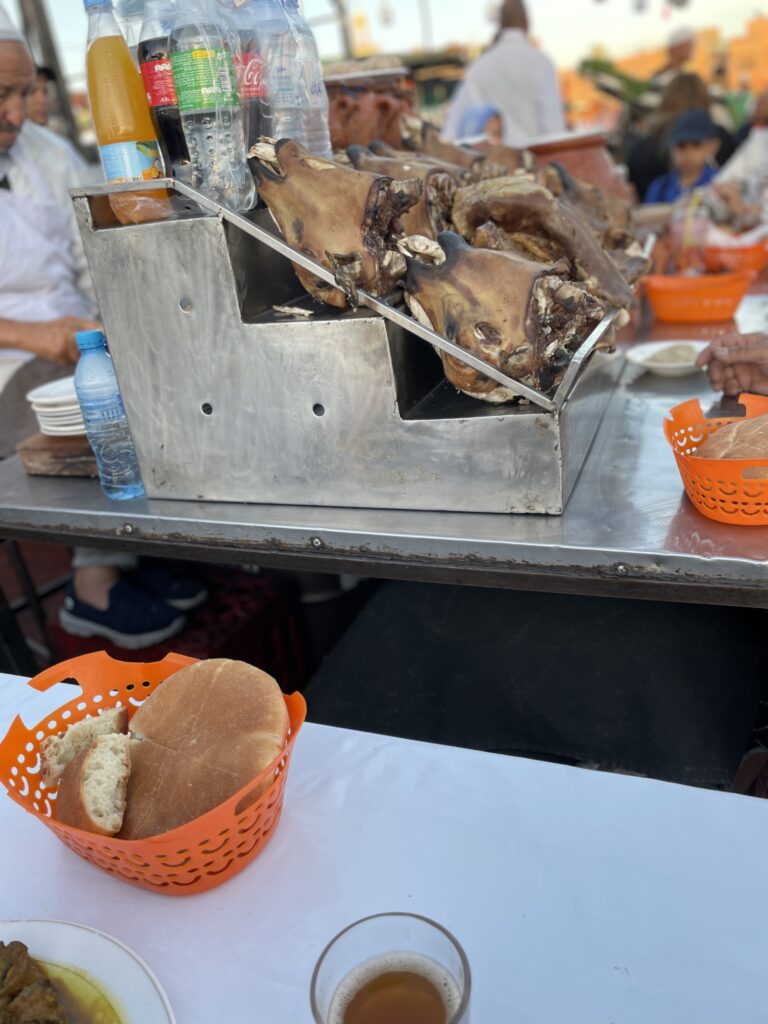
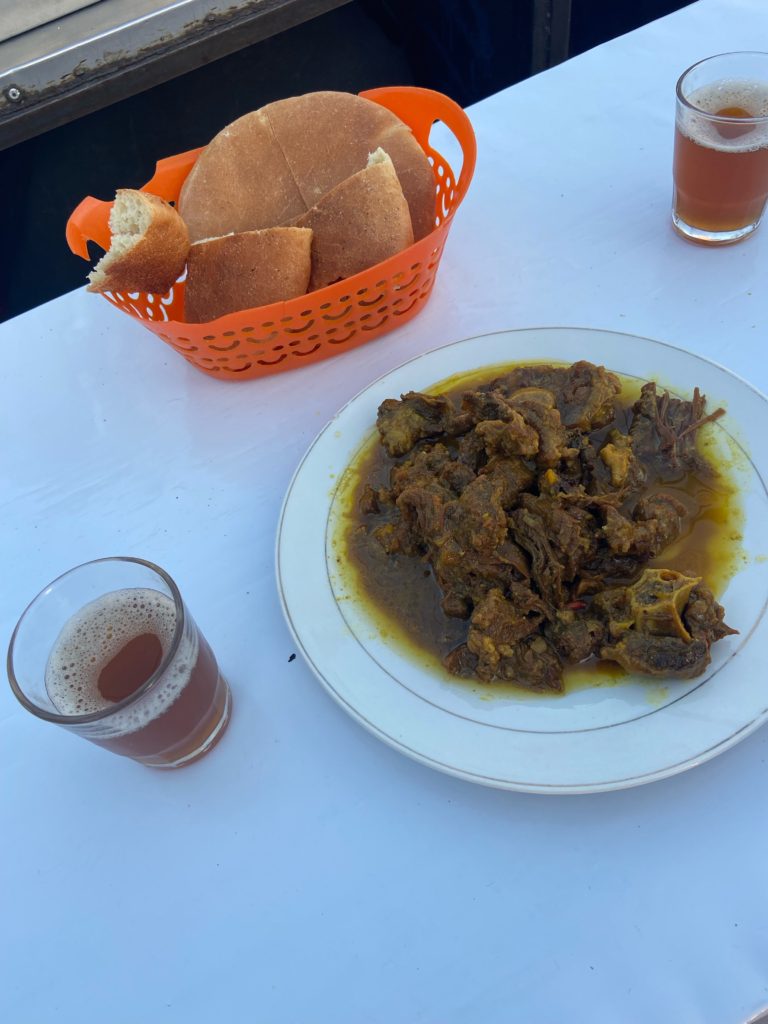
Stop 3 Stall #27 Chicken Shawarma and Moroccan Soup (Harira)
Our third stop on our journey was for some chicken shawarma and Moroccan soup or Harira. For those who don’t know, chicken shawarma consists of thinly sliced meat laid on a flatbread, served with lettuce, tomato slices, onion, and yogurt sauce.
It is personally one of my favorite foods, and we would rate it a 10/10!
We also had Moroccan soup also known as Harira at this stop. Which is made with dried legumes, lentils, chickpeas, and fava beans and is traditionally cooked with lamb or lamb broth. The soup was very good and a nice change up from all of the meat and cous cous we had been having on our trip.
Moroccan Soup or Harira rating 8.3/10.
Miscellaneous Fod Vendors
Following the food tour, we decided to digest with a nice stop at the juice stand. We found ourselves going to a different vendor each time and ending up with the same result it rocked!
Juice choices Orange and Pomegranate score 10/10!
We finished our Jemaa el-Fnaa food tour by stopping at the dessert cart. We had Moroccan Cinnamon Cookies, Baklava, and Maamoul. Maamoul is an Arabian date-filled cookie. Each dessert was delicious and was a phenomenal finish to the night!
Dessert rating 7.8/10.
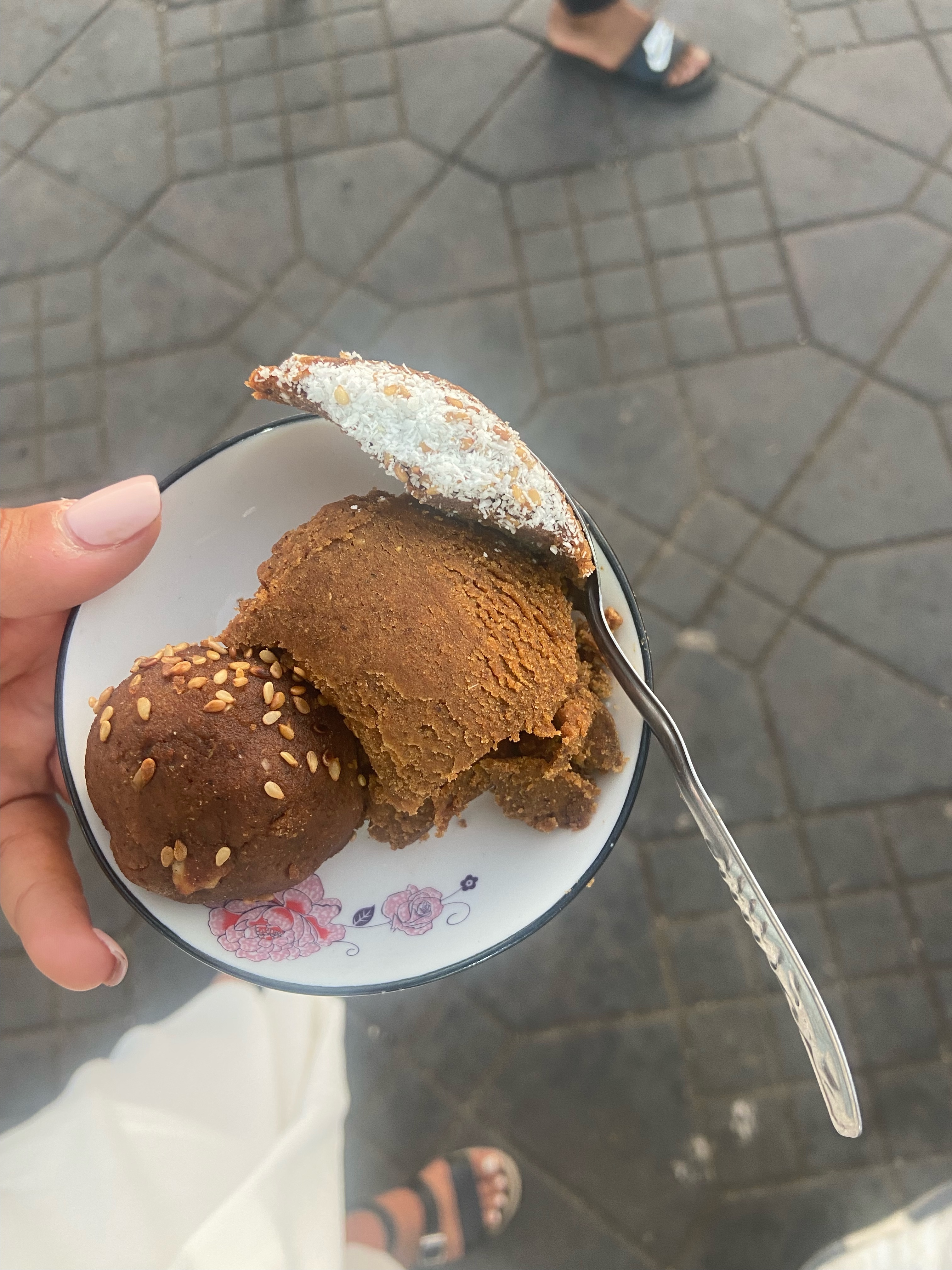
We forgot to track what each individual food item cost while doing the food tour, but all in all we ended up spending around 161 Moroccan Dirhams or about $15 USD.
Along with the food tour, we also took some more time to check out the different shops and merchant shops that were still open. We were able to pick up some Moroccan spices and tea to bring home for our friends and family! We ended up really liking Jemaa el-Fnaa market and were glad we saw it both during the daytime and nighttime.
Now, while we ended up loving the market, we also learned some important lessons that we thought were worth sharing with everyone else!


Jemaa el-Fnaa Tips/Disclosures
Lesson 1: Do not pay the original asking price at any merchant shop.
Jemaa el-Fnaa was built on negotiating, and shop owners will try to take advantage of you when they notice you are a tourist. At any merchant shop, you are able to negotiate the price down and get a better deal.
Some tips I found helpful when negotiating included setting a price that I would not pay more than and not being afraid to walk away if the price was not good enough.
One important thing to also note is that this does not apply to the food stalls! While we are not positive that you can not bargain at the food stalls, we never saw anyone do it, and the food is already so fairly priced that it would feel wrong.
Lesson 2: Do not visit the Berber Market.
Like any country, Morocco has people preying on tourists and creating different scams to try and take money from negligent visitors. When walking around areas surrounding the Jemaa el-Fnaa market, they will approach people claiming they want to practice their English.
These people will also mention how you are “so lucky that you came to the market on this day as the Berber Market is also going on.” They will try and convince you that the local people of the Berber Village come down once a month to sell their homemade and natural goods. These claims UNTRUE and a tourist scam. The people who run these scams are shop owners in a different part of town, and it is a total scam.
Do not fall for this unless you are trying to waste time wandering the city and getting hassled to buy overpriced goods in exchange for a “tour.”
Lesson 3: Do not walk straight through the center of the market.
Unless you like being surrounded by different shop and restaurant owners, do not walk straight through the center of the market.
We made this mistake and had ten people encircling us, trying to get us to eat at their shop. Rather than going straight in, try doing a few laps around the market to get your bearings. You can see what food stalls you would like to visit, thus leading to less hassle.
We also made it a point to go to the food stalls where the owner hassled us the least.

Jemaa el-Fnaa is a spectacular market and a once-in-a-lifetime experience to visit. You get both an amazing cultural perspective of what local life is like, as well as getting to try some local delicacies and specialties.
We would highly recommend visiting Jemaa el-Fnaa and traveling to Morocco!
Till next time – Josh 🙂
Check out our blog detailing our stay in the Agafay Desert!
Food looks amazing! I want to try snail soup!
I loved learning about the market and appreciate the tips too. The food looks amazing. I love your pictures.